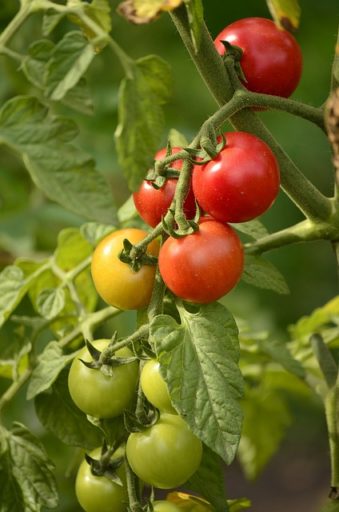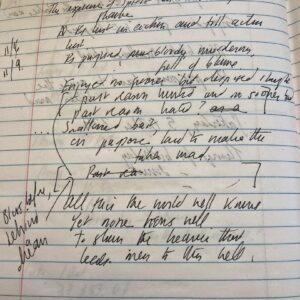This seemingly endless summer, in the middle of this seemingly endless plague year of 2020, has given me at least one thing: It is the year I began to grow things in earnest. For years I’d annually buy a pot or two of herbs, or a sole tomato plant, and sometimes they’d grow and sometimes I’d forget and they’d just drown in dry dirt.
In November, I might find the wispy brown remains, in their supermarket plastic pot, hardened to one lump in the first frost, under the brick backyard stairs.
Not so this summer. And it’s not as though I’ve done all that much more than I had done before. I did not embark on the kind of totalizing, theory-meets-practice “under COVID” project like I’ve seen others do—building backyard sheds, deciding to homeschool from now on, moving to Idaho. I just purchased a few more plants this year—two tomato plants instead of one, a squash, some hot peppers, some rosemary and basil. I did not start them as seedlings, but bought them. I planted them all in pots on my back porch. So it was not exactly heavy lifting.
But this year, the lessons of growing things were more powerful, and stark. The tomatoes limped along timidly. The first ones ripened and then the plants just sat for a couple of weeks, flower-less, no promise of fruit in the offing. The squash plant, though, went wild: as the weeks of June and July passed, the plant twisted up from the terra cotta pot and twined around the stair rail, unfolding palm-sized green leaves and a waterfall of golden flowers. I was thrilled when I found the first thumb-sized squash hanging from a spent petal.
Then something happened. I came out the back door and the squash leaves had shriveled. The little squash was disintegrating. I watered the plant until it was clear that watering was not the problem.
But then I found the dark, wet mold that had covered the bottom of the stem, splitting the stalk in two, and ruining the whole plant. After all those weeks of its gaudy beauty, I was hoping there’d be some way to force its resurrection. I considered just leaving the dying plant—where had those gorgeous flowers gone? At last, though, I held my breath, ripped the soggy stalk out of the soil and threw it over the railing onto the ground ten feet below, where it was raked up by my husband and put out with the yard clippings.
The experience was a painfully concrete illustration of the parable of the Sower and the Seed. Although it wasn’t planted on rock, the squash plant had appeared to flourish, but the stalk was not strong enough to support the blossoms and gorgeous leaves.
It took me a week or two of mourning before I rowed my hands through the soil, then transplanted a little paper-wrapped cube of basil sprouts into the giant pot, hoping it would not look lost. Now, a week or two further past that, the basil is pushing itself upward, in multiple directions now—enough of a profusion of leaves that I might be ready to make some pesto.
Meanwhile, the tomato plants rebounded. Wildly. They went from being a couple of leafy green stems with their original fruits gone, to being covered with blossoms, and now, a profusion of small green tomatoes. It is a delight to go into the backyard and count them up. They are like little rewards, all for me. They should be ready in the next couple of weeks.
Now all the rain from recent thunderstorms has sent the tomato stems spiraling out of control—so much that it’s been a challenge to hold up the stems. It’s too late and the things are too big for me to use the tomato cages the way they are meant to be used, so I have jury-rigged a thing with stakes and twine. But that has made the whole structure unwieldy, and more than once, I’ve found the plants just toppled over after a heavy wind has blown through.
Clearly, it’s time to do something. I need to take the clippers in hand and just whack some of these limbs off. I’m too scared, though, that in the process of pruning, I’ll jeopardize the existing tomatoes. But if I don’t prune the limbs, the plant will smother itself.
You see the obvious analogies here—both in terms of the spiritual life and the literary one, as well. Seeing my own hand directly tied to the reality of these plants either living or dying has certainly made me think of my own impending death.
It’s also made me think about what makes literature live.
As I write this essay, I’m in the throes of writing the final fourth of a manuscript I’ve been working on in earnest for the past two years, but with writings I’ve compiled over the last ten. While I think that the manuscript moves forward at a pretty decent clip, I’m aware of my own impatience, and eagerness in bringing the whole damned thing to a close.
I’m afraid that once I’m done, the manuscript will be front-heavy, and baggy, and speed too rapidly to a close without enough justified resolution. (“Unearned endings,” were what we called these in my MFA program.) It’s not just my problem: Name a popular literary novel from the past decade, and more often than not, the first three hundred pages are slow and crafted and heavy, and the final two as explosive as an action film. (Jonathan Franzen? Meg Wolitzer? Are you listening?)
I’ll fix it on the rewrite, I tell myself. But I can do the spiritual work now—of ensuring that the narrative thread is more about art, and less about self. Where is the story? I will ask, and adjust up or down as needed.
Just as, one way or another, I’ll find the courage to snap off the superfluous tangle of tomato stems. And try to bring the precious tomatoes a dose of extra light.
To bring some life, in other words, out of death once again.
Caroline Langston was a regular contributor to Image’s Good Letters blog, and is writing a memoir about the U.S. cultural divide. She has contributed to Sojourners’ God’s Politics blog, and aired several commentaries on NPR’s All Things Considered, in addition to writing book reviews for Image, Books and Culture, and other outlets. She is a native of Yazoo City, Mississippi, and a convert to the Eastern Orthodox Church. She lives outside Washington, D.C., with her husband and two children.





